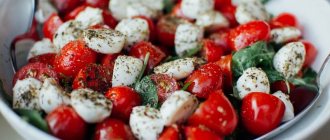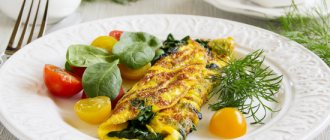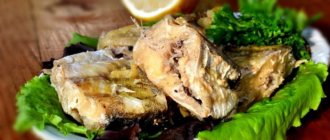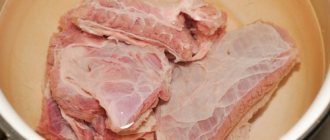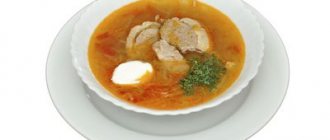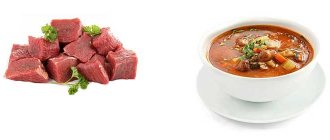Related Products
Turkey Liver (158 cal) Ground Turkey (226 cal) Dark Meat Turkey (184 cal) Roast Turkey (231 cal) Baked Turkey (220 cal) Turkey Stuffing (203 cal) Lean Turkey (110 cal) .) Cooked Turkey (177 cal) Whole Turkey (168 cal) Grilled Turkey (166 cal) Frozen Turkey (129 cal) White Meat Turkey (152 cal) Turkey Neck (125 cal) Turkey Giblets (124 cal) .) Turkey Drumstick (175 cal) Fried Turkey (279 cal) Turkey Leg (144 cal) Turkey Tail (187 cal) Turkey Wing (228 cal) Turkey Thigh (164 cal) Canned Turkey (169) (cal) Seasoned Turkey (129 cal) Turkey Belly (155 cal) Turkey Skin (425 cal) Turkey Heart (174 cal)
Useful properties of turkey
The beneficial properties of dietary turkey meat are due to its rich chemical composition. Systematic consumption of poultry (fillet, wings, breast, drumstick, neck, etc.) has a multifaceted positive effect on the body:
- The condition of the skin improves.
- Energy increases, nervousness and weakness decrease, absent-mindedness disappears.
- Sleep is normalized and the nervous system is strengthened thanks to the essential amino acids included in the product, which affect brain function. The mood improves, it becomes easier for a person to get rid of tension and relax after a hard day or physical activity.
- Teeth and bones are strengthened due to calcium and phosphorus contained in turkey meat.
- The functioning of the thyroid gland and the production of hormones are normalized. Turkey can be eaten to prevent thyroid diseases.
- Turkey meat is a preventative against age-related cognitive impairment.
- The product strengthens the immune system.
- The level of bad cholesterol in the blood decreases, and the level of good cholesterol increases.
- Improves pancreatic function
- Regular consumption of skinless meat reduces the risk of pancreatic cancer.
- Endurance increases and muscles become stronger - for this reason the product is especially valued by athletes. Due to not only the high protein content in the composition, meat helps to form strong muscles and increases performance, thereby increasing the productivity of physical activity.
Regular consumption of poultry improves the functioning of the gastrointestinal tract, relieves constipation and accelerates metabolic processes.
Note: turkey stomachs and skin also have a rich set of minerals, however, while the former can be eaten during a diet due to their low calorie content, the skin of the bird does not have any beneficial effect on the body. Turkey fat has nutritional properties and can be used in cooking in moderation.
© OB — stock.adobe.com
Benefits of poultry liver
Poultry liver contains a large amount of proteins and minerals and vitamins necessary for the body to function properly. The benefits of systematic use of the product in moderate quantities (100-150 g per day) are manifested as follows:
- the process of hematopoiesis improves, thereby reducing the risk of developing anemia;
- the aging process slows down;
- cell recovery is accelerated;
- the functioning of the reproductive system in women improves;
- the walls of blood vessels are strengthened and the functioning of the immune system is improved;
- visual acuity increases;
- strengthens nails and hair;
- the functioning of the thyroid gland is normalized.
The product contains nicotinic acid, which is often used in medications to treat diseases such as atherosclerosis, liver damage, pellagra, etc.
Health Benefits of the Heart
Turkey heart is widely used in cooking and has many beneficial properties. Doctors recommend including offal (prepared in any way except frying) in the diet of people:
- those suffering from disorders of the formation of blood cells and anemia;
- with poor vision;
- athletes and people of physical labor;
- with depressive disorders;
- with chronic fatigue syndrome;
- those working in positions that require increased brain activity (doctors, teachers, etc.).
Heart is recommended for regular use by people who are often exposed to stress or nervous strain.
Composition of nutrients, BJU
Turkey breast
| For quantity: 100 grams | ||
| Calories — 146 | Calories from fat - 31 | |
| BJU | ||
| Total fat content | 3.49g | |
| Saturated | 1g | |
| Polyunsaturated | 0.96g | |
| Monounsaturated | 1.16g | |
| Cholesterol | 70mg | |
| Total carbohydrate content | 0.01g | |
| Dietary fiber | 0g | |
| Sugar | 0g | |
| Squirrels | 27.78g | |
| Vitamins and microelements | ||
| A - 3.14 µg | C - 0mg | |
| B-6 - 0.67 mg | B-12 - 0.81mcg | |
| D - 0.24 µg | E - 0.07 mg | |
| Calcium 14 µg | Iron 0.84 mg | |
| Magnesium 27.71 mg | Zinc 1.6mg | |
| Potassium 270 mg | Sodium 173 mg | |
Distribution of calories for BJU:Carbohydrates (3%) Fats (21%) Proteins (76%) | ||
Calories in Turkey breast fillet. Chemical composition and nutritional value.
Nutritional value and chemical composition of “Turkey breast fillet”.
The table shows the nutritional content (calories, proteins, fats, carbohydrates, vitamins and minerals) per 100 grams of edible portion.
| Nutrient | Quantity | Norm** | % of the norm in 100 g | % of the norm in 100 kcal | 100% normal |
| Calorie content | 100 kcal | 1684 kcal | 5.9% | 5.9% | 1684 g |
| Squirrels | 20 g | 76 g | 26.3% | 26.3% | 380 g |
| Fats | 2.5 g | 56 g | 4.5% | 4.5% | 2240 g |
| Water | 74.89 g | 2273 g | 3.3% | 3.3% | 3035 g |
| Ash | 1.04 g | ~ | |||
| Vitamins | |||||
| Vitamin A, RE | 6 mcg | 900 mcg | 0.7% | 0.7% | 15000 g |
| Retinol | 0.006 mg | ~ | |||
| Vitamin B1, thiamine | 0.042 mg | 1.5 mg | 2.8% | 2.8% | 3571 g |
| Vitamin B2, riboflavin | 0.145 mg | 1.8 mg | 8.1% | 8.1% | 1241 g |
| Vitamin B4, choline | 61.3 mg | 500 mg | 12.3% | 12.3% | 816 g |
| Vitamin B5, pantothenic | 0.775 mg | 5 mg | 15.5% | 15.5% | 645 g |
| Vitamin B6, pyridoxine | 0.813 mg | 2 mg | 40.7% | 40.7% | 246 g |
| Vitamin B9, folates | 7 mcg | 400 mcg | 1.8% | 1.8% | 5714 g |
| Vitamin B12, cobalamin | 0.63 mcg | 3 mcg | 21% | 21% | 476 g |
| Vitamin D, calciferol | 0.1 mcg | 10 mcg | 1% | 1% | 10000 g |
| Vitamin D3, cholecalciferol | 0.1 mcg | ~ | |||
| Vitamin E, alpha tocopherol, TE | 0.06 mg | 15 mg | 0.4% | 0.4% | 25000 g |
| gamma tocopherol | 0.01 mg | ~ | |||
| Vitamin RR, NE | 9.924 mg | 20 mg | 49.6% | 49.6% | 202 g |
| Betaine | 2.5 mg | ~ | |||
| Macronutrients | |||||
| Potassium, K | 242 mg | 2500 mg | 9.7% | 9.7% | 1033 g |
| Calcium, Ca | 11 mg | 1000 mg | 1.1% | 1.1% | 9091 g |
| Magnesium, Mg | 28 mg | 400 mg | 7% | 7% | 1429 g |
| Sodium, Na | 113 mg | 1300 mg | 8.7% | 8.7% | 1150 g |
| Phosphorus, P | 201 mg | 800 mg | 25.1% | 25.1% | 398 g |
| Microelements | |||||
| Iron, Fe | 0.73 mg | 18 mg | 4.1% | 4.1% | 2466 g |
| Manganese, Mn | 0.011 mg | 2 mg | 0.6% | 0.6% | 18182 g |
| Copper, Cu | 70 mcg | 1000 mcg | 7% | 7% | 1429 g |
| Selenium, Se | 22.7 mcg | 55 mcg | 41.3% | 41.3% | 242 g |
| Zinc, Zn | 1.28 mg | 12 mg | 10.7% | 10.7% | 938 g |
| Digestible carbohydrates | |||||
| Starch and dextrins | 0.09 g | ~ | |||
| Mono- and disaccharides (sugars) | 0.05 g | max 100 g | |||
| Sucrose | 0.05 g | ~ | |||
| Essential amino acids | |||||
| Arginine* | 1.34 g | ~ | |||
| Valin | 0.756 g | ~ | |||
| Histidine* | 0.641 g | ~ | |||
| Isoleucine | 0.678 g | ~ | |||
| Leucine | 1.64 g | ~ | |||
| Lysine | 1.952 g | ~ | |||
| Methionine | 0.619 g | ~ | |||
| Threonine | 0.859 g | ~ | |||
| Tryptophan | 0.252 g | ~ | |||
| Phenylalanine | 0.763 g | ~ | |||
| Nonessential amino acids | |||||
| Alanin | 1.279 g | ~ | |||
| Aspartic acid | 1.892 g | ~ | |||
| Hydroxyproline | 0.11 g | ~ | |||
| Glycine | 1.01 g | ~ | |||
| Glutamic acid | 3.209 g | ~ | |||
| Proline | 1.278 g | ~ | |||
| Serin | 0.937 g | ~ | |||
| Tyrosine | 0.703 g | ~ | |||
| Cysteine | 0.223 g | ~ | |||
| Sterols (sterols) | |||||
| Cholesterol | 57 mg | max 300 mg | |||
| Fatty acid | |||||
| Trans fats | 0.013 g | max 1.9 g | |||
| monounsaturated trans fats | 0.01 g | ~ | |||
| Saturated fatty acids | |||||
| Saturated fatty acids | 0.289 g | max 18.7 g | |||
| 10:0 Kaprinovaya | 0.004 g | ~ | |||
| 12:0 Lauric | 0.003 g | ~ | |||
| 14:0 Miristinovaya | 0.004 g | ~ | |||
| 15:0 Pentadecane | 0.002 g | ~ | |||
| 16:0 Palmitinaya | 0.177 g | ~ | |||
| 17:0 Margarine | 0.003 g | ~ | |||
| 18:0 Stearic | 0.093 g | ~ | |||
| 20:0 Arakhinovaya | 0.002 g | ~ | |||
| 22:0 Begenovaya | 0.002 g | ~ | |||
| Monounsaturated fatty acids | 0.264 g | min 16.8 g | 1.6% | 1.6% | |
| 14:1 Myristoleic | 0.001 g | ~ | |||
| 16:1 Palmitoleic | 0.023 g | ~ | |||
| 16:1 cis | 0.023 g | ~ | |||
| 17:1 Heptadecene | 0.001 g | ~ | |||
| 18:1 Oleic (omega-9) | 0.235 g | ~ | |||
| 18:1 cis | 0.226 g | ~ | |||
| 18:1 trans | 0.01 g | ~ | |||
| 20:1 Gadoleic (omega-9) | 0.003 g | ~ | |||
| 24:1 Nervonic, cis (omega-9) | 0.001 g | ~ | |||
| Polyunsaturated fatty acids | 0.258 g | from 11.2 to 20.6 g | 2.3% | 2.3% | |
| 18:2 Linolevaya | 0.2 g | ~ | |||
| 18:2 trans isomer, undetermined | 0.003 g | ~ | |||
| 18:2 Omega-6, cis, cis | 0.196 g | ~ | |||
| 18:3 Linolenic | 0.009 g | ~ | |||
| 18:3 Omega-3, alpha-linolenic | 0.009 g | ~ | |||
| 20:2 Eicosadiene, Omega-6, cis, cis | 0.003 g | ~ | |||
| 20:3 Eicosatriene | 0.005 g | ~ | |||
| 20:3 Omega-6 | 0.005 g | ~ | |||
| 20:4 Arachidonic | 0.028 g | ~ | |||
| Omega-3 fatty acids | 0.014 g | from 0.9 to 3.7 g | 1.6% | 1.6% | |
| 22:4 Docosatetraenoic acid, Omega-6 | 0.009 g | ~ | |||
| 22:5 Docosapentaenoic acid (DPA), Omega-3 | 0.003 g | ~ | |||
| 22:6 Docosahexaenoic acid (DHA), Omega-3 | 0.002 g | ~ | |||
| Omega-6 fatty acids | 0.241 g | from 4.7 to 16.8 g | 5.1% | 5.1% |
The energy value of Turkey breast fillet is 100 kcal.
Primary Source: Created in the application by the user. Read more.
** This table shows the average levels of vitamins and minerals for an adult. If you want to know the norms taking into account your gender, age and other factors, then use the “My Healthy Diet” application.
Turkey as a menu item for weight loss
Turkey fillet and breast are considered the most suitable for weight loss, since these parts of the bird are the lowest in calories. Turkey meat helps keep muscles toned and saturates the body with minerals and vitamins necessary for normal functioning.
The recommended daily dose of product consumption is 250-300 g, for weight loss – 150-200 g.
With regular consumption of poultry meat, the digestion process improves, due to which metabolism accelerates, and additional energy appears in the body, which stimulates the body to be active (in the case of those losing weight, to play sports).
For weight loss purposes, the method of preparing poultry is important. The most suitable option is baking in the oven, boiling, steaming or grilling.
A little information on cooking time:
- breast or fillet must be cooked for half an hour;
- thigh or lower leg - within one hour;
- whole carcass – at least three hours;
- It takes at least two and a half hours to bake a whole bird (4 kg).
For the marinade, you cannot use sour cream or mayonnaise; you should limit yourself to lemon juice, various spices, soy sauce, wine vinegar, garlic, mustard. You can use a small amount of honey.
© Andrey Starostin — stock.adobe.com
Protein in dark meat
The term "dark" is used to describe cuts of meat that are reddish-brown in color.
The sections have this pigment due to the high concentration of the protein myoglobin ().
Because myoglobin helps transport and store oxygen in muscle cells, dark meat is typically found in more active muscle groups, such as chicken and turkey thighs and drumsticks ().
Drumstick meat
A 100-gram serving of cooked chicken drumstick contains slightly less protein than the same serving of turkey drumstick—about 2.2 grams (,).
- Chicken drumstick : 27 grams
- Turkey drumstick : 29.2 grams
This slight difference in the amount of protein makes both of these products virtually identical in terms of nutritional content.
Thigh meat
Thigh meat from both chicken and turkey contains slightly less protein than drumstick meat. Sometimes the thighs are sold still attached to the drumsticks - in one piece (leg).
A 100-gram serving of turkey thigh meat contains approximately 2.5 grams more protein compared to chicken (,):
- Chicken thigh : 26 grams
- Turkey thigh : 28.5 grams
While turkey thigh meat is technically the richer source of protein in this comparison, 2.5 grams of protein per 100 grams is unlikely to make much difference overall. Either choice will still qualify as a good source of high-quality protein.
Conclusion:
The protein content of chicken and turkey drumsticks and thighs is almost the same, although turkey meat contains just over 2 grams more protein than chicken meat per 100-gram serving.

